
Ecology in Poland: deep dive into conservation and biodiversity
Poland, nestled in the heart of Central Europe, is a country rich in natural resources and diverse ecosystems. From the sprawling Białowieża Forest, home to the European bison, to the picturesque Tatra Mountains, Poland's ecological landscape is as varied as it is vital. This article explores the current state of ecology in Poland, the challenges it faces, and the ongoing efforts towards conservation and sustainability, CE Report reports.
Diverse Ecosystems
Poland boasts a remarkable range of ecosystems, including forests, wetlands, rivers, and mountains.
Forests: Covering about 30% of the country, Polish forests are largely coniferous and deciduous. The Białowieża Forest, a UNESCO World Heritage site, is one of the last remaining primeval forests in Europe and is recognized for its rich biodiversity, including the European bison, lynx, and a variety of endemic plant species.
Wetlands: Wetlands play a crucial role in Poland’s ecology, acting as natural water filters and providing habitats for countless species. The Biebrza Marshes, another significant ecological area, is home to an impressive variety of bird species, making it a prime location for birdwatching and ecological research.
Mountains: The Tatra Mountains serve as a natural border with Slovakia and host diverse flora and fauna. This region is protected under the Tatra National Park, which focuses on both conservation and sustainable tourism.
Environmental Challenges
Despite its rich ecological heritage, Poland faces various environmental challenges:
Air Pollution: Poland has been grappling with severe air pollution, primarily due to coal burning for energy and heating. This has adverse effects on human health and biodiversity. The government has initiated policies aimed at reducing emissions and promoting cleaner energy sources.
Deforestation: While Poland’s forest cover is relatively stable, illegal logging and unsustainable forestry practices, especially in protected areas, pose significant threats to biodiversity. Efforts to combat deforestation include stricter regulations and increased monitoring of logging activities.
Agricultural Practices: Industrial agriculture has intensified in Poland, leading to habitat destruction and a decline in biodiversity. The use of pesticides and fertilizers can contaminate soil and water systems, adversely affecting local ecosystems.
Climate Change: Like many countries, Poland is feeling the effects of climate change, with increased flooding, droughts, and temperature changes impacting agricultural productivity and natural habitats.
Conservation Efforts
In response to these challenges, Poland has undertaken various conservation initiatives:
Protected Areas: Approximately 30% of Poland's land area is designated as protected, including national parks, nature reserves, and landscape parks. These areas are critical for preserving biodiversity and providing sanctuaries for endangered species.
Biodiversity Strategies: The Polish government has implemented National Biodiversity Strategies in line with the European Union's directives, focusing on the preservation and restoration of ecosystems and habitats.
Sustainable Forestry Practices: Organizations such as the State Forests National Forest Holding are working towards sustainable forestry practices that balance economic needs with ecological preservation. This includes certification schemes that ensure timber is sourced responsibly.
Public Awareness and Education: Educational programs and activities aimed at increasing public awareness of ecological issues are crucial for fostering a culture of conservation. Non-governmental organizations (NGOs) play a significant role in these efforts, engaging local communities and promoting sustainable practices through various initiatives.
Renewable Energy: Poland is making strides in transitioning to renewable energy sources. Investments in wind and solar energy are gaining momentum, aiming to reduce reliance on coal and improve air quality.
Conclusion
Poland's ecology is a treasure trove of biodiversity and natural beauty, but it is also at a crossroads, facing various environmental challenges that require immediate attention and action. Through the collaborative efforts of the government, NGOs, and local communities, Poland is working towards sustainability and conservation, ensuring that future generations can enjoy its rich natural heritage. As the country continues on this path, Poland serves as an example of the delicate balance between development, conservation, and the pursuit of a sustainable future in the heart of Europe.
























